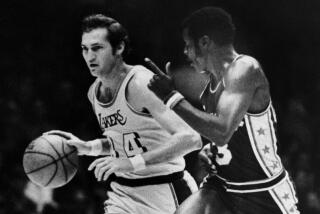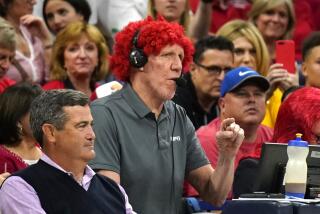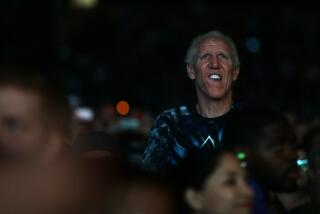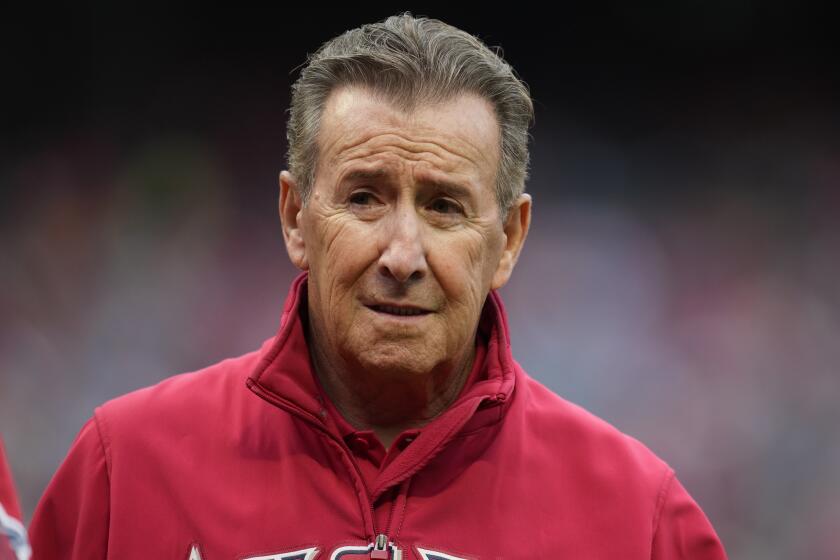Basketball fans have an attraction to distraction
The years rolled past and Speedo Guy got on with his life. He married and started a family. He became a priest.
“It seems kind of silly trying to make a connection with what happened back then,” he says.
But the game of basketball does not forget so easily.
Eight years ago, as a graduate student at Duke, Patrick King snagged a ticket to watch his team face rival North Carolina, joining a horde of classmates in a section directly behind one of the baskets at Cameron Indoor Stadium.
The “Cameron Crazies” have a reputation for jumping and screaming and waving their hands when an opponent steps to the free-throw line. King tried something different.
Video: The legend of ‘Speedo Guy’
At one point during the 2003 game, with North Carolina guard Jackie Manuel awarded two foul shots, he arranged for his compatriots to sit quietly, which, in itself, seemed eerie. Then, King stripped down to a skimpy swimsuit, stood on his seat and began gyrating.
The first shot bounced away, which made King dance even harder. Manuel missed again.
“Mission accomplished,” King says. “That was exactly what we wanted.”
Video of his “Speedo Guy” antics eventually went viral on YouTube and King made his mark on the sport’s folklore, the embodiment of diehard fans who will try almost anything to rattle the free-throw shooter.
::
Tiger Woods never deals with hecklers when he lines up a 15-foot putt at the Masters. Major league batters have dark, solid screens in center field so they can see pitches clearly and NFL kickers are looking down when they make contact with the ball.
Basketball is different from other major sports in that the crowd is rowdy, close and perched directly in the athletes’ line of sight. Even the backboard, made of glass, provides no shield.
With the NCAA tournament in full swing — Duke arrives at Honda Center in Anaheim to face Arizona in the West Regional semifinals Thursday — yelling and stomping are only part of the equation. The art of distraction has grown more complex.
King’s odd dance was part of an evolution that now has fans dressing in fluorescent Spandex body suits and waving long, wriggling tubes called “thunder sticks” behind the basket. They bring stuffed animals to toss into the air as the shooter takes aim.
“Crazy stuff,” said USC guard Jio Fontan, whose team lost to Virginia Commonwealth in the tournament’s first round last week. “Sometimes it can spook you.”
Lawrence Tanter sets the tone for the Lakers, and jazz station
Players at the line might look up to see posters of scantily clad women, not-so-subtle messages such as “Brick” and “Miss” or circles painted with swirls, fans spinning them as if to hypnotize.
San Diego State, which also plays Thursday in Anaheim, is one of several schools where the crowd holds up giant cardboard heads, a bobbing sea of faces that include Borat, Justin Bieber and Abraham Lincoln.
If all this sounds like the stuff of college students with too much time on their hands, check out the NBA.
The Portland Trail Blazers have the bellowing “Free Throw Guy” and the New Orleans Hornets crowd once tried to distract San Antonio Spurs guard Tony Parker with a life-size cutout of his then-wife, Eva Longoria. Boston Celtics executive Danny Ainge was fined $25,000 last season for throwing a towel into the air as a rival player was about to shoot during a playoff game.
But no place has a reputation for tomfoolery like Duke, where students line up outside Cameron long before tipoff and spend hours devising special chants and costumes meant to annoy.
The Speedo idea started with King’s buddy and King said he would try it if the crowd cooperated by sitting quietly. The unofficial leaders of the student section — two regulars known as Viking Guy and Mullet Man — helped spread the word.
“It was a whole experiment in groupthink,” King said. “Everyone agreed.”
The second time North Carolina went to the line, the students promptly took their seats. For a suddenly jittery King, there was no turning back.
Arms outstretched, he rose above the crowd. With each swivel of his hips, each pump of his arms, the dance grew wilder.
“I just went with it, man.”
::
No one has studied the effects of fan behavior on free throws, but neuroscience experts have their suspicions about what works — and what does not.
In observing players at all levels, University of Calgary professor Joan Vickers found the most successful shooters fix their gaze on the rim for about a second before releasing the ball. That gives various parts of the brain time to coordinate.
“Your brain is like a GPS system,” she said. “It’s picking up the height of the basket and the distance … reading all that and putting it into a neural network.”
Experts believe the old-style distraction — masses of arms or thunder sticks waving randomly — form a visual white noise that can be easily ignored. Fans are better off getting the shooter to glance away.
Hence the giant faces and posters of attractive women. Or a semi-naked grad student.
Vickers, who wrote a book called “Perception, Cognition and Decision Training,” explained: “If you’re looking all over the place, imagine punching all sorts of numbers into a GPS. It’s a mess.”
Another potential strategy involves altering a player’s perception.
Around the same time King was stripping down, University of California associate professor David Whitney was conducting a study in which subjects tried to reach toward a fixed point set against a moving background.
The brain is wired to adjust for motion. For instance, if you grab a coffee cup while walking past a table, you need to account for the one or two steps between the time you start to reach and the moment when your fingers grasp the cup.
If you are standing still, a background that shifts to the left can make your brain think you are moving to the right and disrupt your aim, Whitney found. Though he has not studied basketball, his data suggests that a coordinated effort by the crowd — everyone swaying to one side or moving up and down in concert — could be effective.
“What the fans should try to do,” he says, “is convince the player that somehow his body position has changed.”
Student sections at Duke and other schools have employed this tactic in recent seasons. No one has done it often enough, or with sufficient regularity, to reach a statistical conclusion.
In the NBA, Daniel Engber, who has a graduate degree in neuroscience, persuaded Dallas Mavericks owner Mark Cuban to give it a try several years ago.
According to an article Engber wrote for slate.com, opposing teams shot poorly from the line for the first two games in which the end-court ticket-holders moved their thunder sticks in unison. Then the Lakers came to town and fared better, at which point the experiment ended.
Again, it was not a sufficient test. Whitney still believes in the potential for group effort.
“If there are enough people and they are moving coherently,” he said, “it could fool the brain.”
::
Distracting the free-throw shooter during March Madness can be tough, if only because, at neutral arenas, fans don’t always sit behind the basket. They must resort to something other than visual aids.
A noisy crowd — the decibels rising to jet plane level — can trigger physiological responses that have been hard-wired into the human circuitry for thousands of years.
The athlete’s reaction to this clamor begins in a part of the brain called the hypothalamus. A warning signal goes out that something bad could be just around the corner, prompting the release of adrenaline and cortisol, which could make the heart rate jump and the pupils dilate.
UCLA Coach Ben Howland grins when he thinks of such moments.
“You’re on the road and the building is packed,” he said. “Everyone is yelling at you.”
Though his Bruins struggled with foul shots in the NCAA tournament, where they lost to Florida in the third round, Howland considers distractions part of the game, a challenge to perform under pressure. Officials agree, to a point.
The NBA prohibits fans from holding signs that create optical illusions, such as those hypnotic circles. NCAA rules draw the line at musical instruments, artificial noisemakers and laser pointers.
Speedo Guy ran into another sort of limitation — the sensibilities of his team’s famous coach, Mike Krzyzewski. King danced at just one more home game in 2003 before Krzyzewski publicly suggested that such behavior was unsuitable at a place of higher learning.
Now, all that remains is the video of King’s moment in the spotlight. But that is sufficient to keep reporters calling with each new season, wanting to do stories. His wife, Caroline, said: “I’ve told him this will never die.”
At 32, King does not seem the least bit bothered by his legacy, even if it clashes with his current occupation, which calls for standing — fully clothed — before a different sort of congregation at the Old North Abbey church in Knoxville, Tenn.
“As a pastor, I value the office,” he said. “It doesn’t mean I have to lose my sense of humor.”
When pressed, he can see a connection between his faith and those days back at Cameron, his contribution to basketball’s art of distraction.
“David was dancing around in a loincloth when he faced Goliath,” King said. “There’s biblical precedent.”
twitter.com/LATimesWharton
More to Read
Go beyond the scoreboard
Get the latest on L.A.'s teams in the daily Sports Report newsletter.
You may occasionally receive promotional content from the Los Angeles Times.











